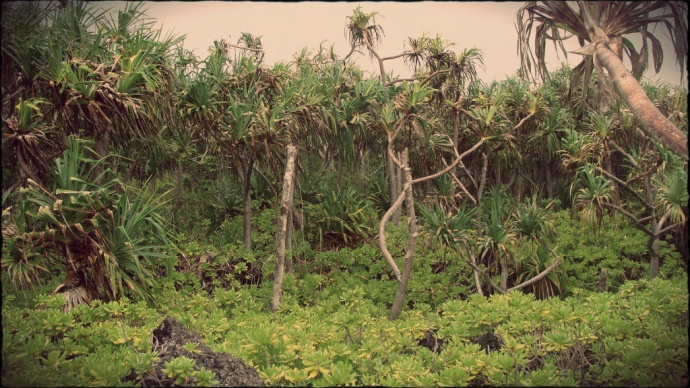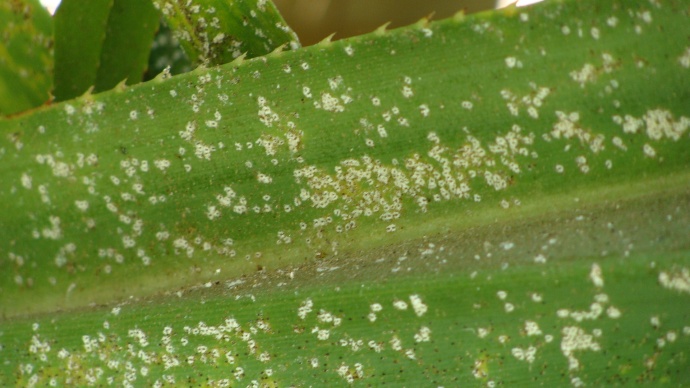Pest Poses Threat to Culturally Significant Hala Trees
By Wendy Osher
“‘A’ohe hala ‘ula i ka pō. No hala fruit shows its color in the darkness of night. (Beauty must be seen to be enjoyed.)” ~’ōlelo no‘eau, Hawaiian proverb & poetical saying. M.K.P.
A tiny pest is slowly taking its toll on Maui hala or pandanus groves, a culturally significant and indigenous tree storied in chant and prized as a cultural resource for weaving, cordage, thatching, lei making, and medicine in Hawai’i.

Mach Fukada inspecting a hala tree at the Maui Nui Botanical Gardens in Kahului. Photo by Wendy Osher.
The hala scale, or thysanococcus pandani, was first found in the islands in the mid 1990s at the Kahanu Botanical Gardens in East Maui, according to state officials. In 2001, it had spread to Keanae; and by the mid 2000s, it was found all over Maui, said Mach Fukada, entomologist with the Hawai’i Department of Agriculture.
“I see it long term impacting a significant cultural resource as well and the dominant tree in the coastal forests on the east side of all of the Hawaiian islands,” said Fukada. “We might see reduction to a point that it will be harder and harder to find this resource.”

The hala scale causes loss of plant vigor, leaf deformation, and other effects. It is present in the form of white fluffy clusters on the leaves, and dark spots on the keys of the hala fruit. Photo by Wendy Osher.
According to Fukada, the hala scale damage includes yellowing of the leaf, leaf deformation, shortening of leaves, prop roots forming in unusual places, and loss of plant vigor. The scale is a tiny creature, believed to have originated from South East Asia. State officials say that once infestation has occurred, the scale covers the leaves, making them look white and fluffy.
Nearly 20 years after its arrival on Maui, and widespread damage already recorded, state officials are hoping to stop its spread to other islands. The state’s exploratory entomologist has the pest on a target list for identification of a potential biological control agent since pesticides and other preventative options have proven unsuccessful. The time frame for implementation, officials say, is difficult to say and dependent on funding.
Pest control of the hala scale has not gotten the same level of attention and funding that other invasive pests – and problem plants for that matter – have, such as the fire weed, gall wasp, and miconia.
“I must be humbug to use short leaves for weaving,” said Fukada who noted the shortening of the leaves as one of the impacts and potential loss of plant vigor as another. “It is the dominant tree in windward coastal areas. Without it, there’s nothing left but ironwood and hau, which were introduced,” he said.
Weavers of lau hala (hala leaves) say they have also noticed a change in quality, and no longer use materials from some East Maui groves that used to provide source material in the past.
According to an online post published by the Hawaiian Ecosystems at Risk project, a similar accidental insect introduction in the South Pacific island of Rarotonga, in the Cook Islands, apparently wiped out the pandanus there in the 1920s.
In the case of the gall wasp and its impact on the leguminous wiliwili trees in Hawai’i, Fukada said, “I don’t think anyone could have projected that in a year, it would spread through the whole state.”
A key factor in battling the hala scale, Fukada said, is to find funds, get permits in place, and have space for quarantine.
“Lots of people have difficulty seeing the value of plants as a cultural and natural resource as opposed to an agricultural commodity,” said Fukada. As a cultural resource, the hala tree is invaluable, he said. “You really can’t put a price on it.”












